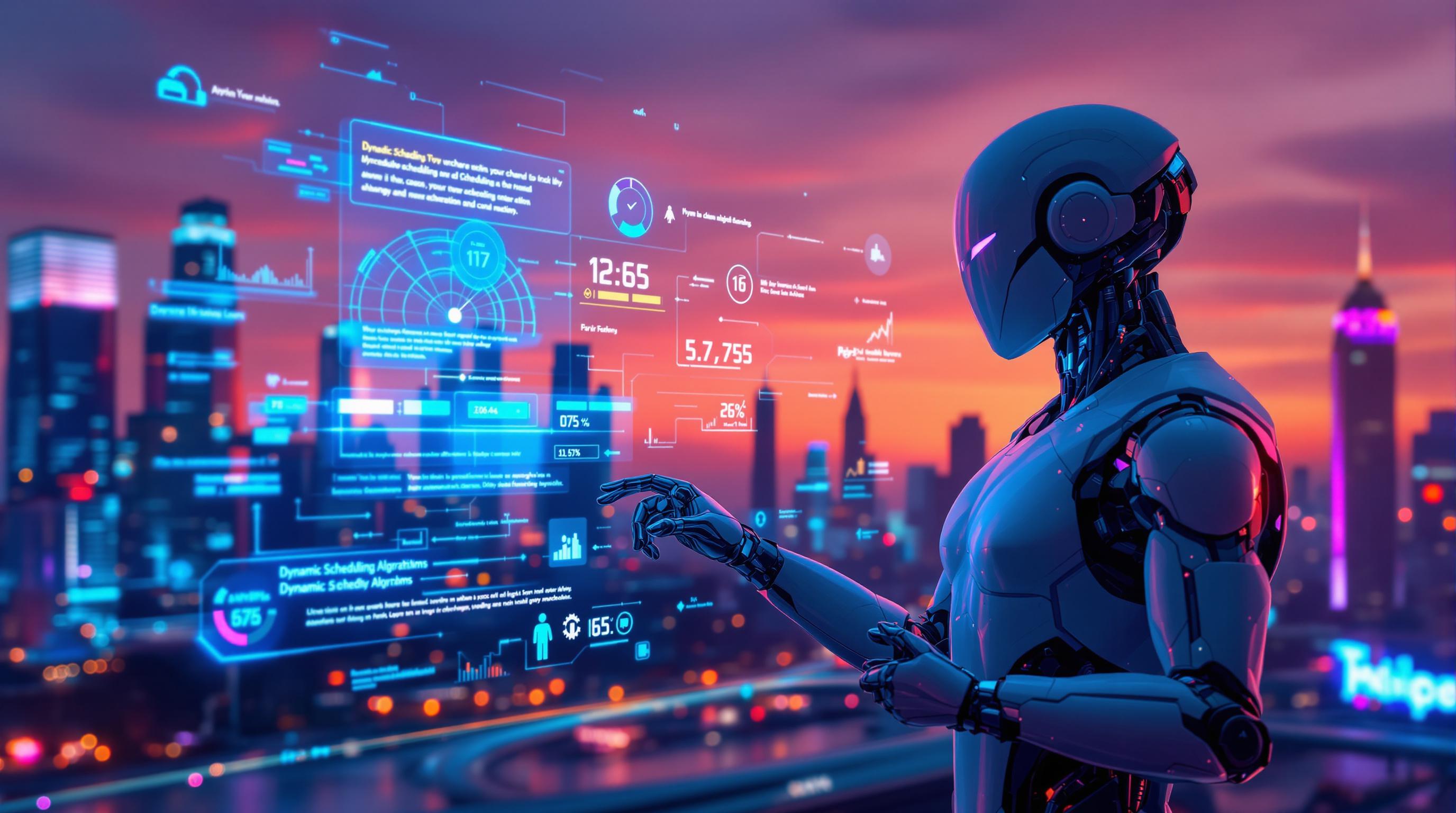Looking to optimize resource allocation with AI? In 2024, AI-driven tools transformed how businesses manage resources, improving efficiency by up to 30% and cutting costs significantly. From predictive analytics to real-time optimization, these tools are reshaping industries like manufacturing, logistics, and financial services.
Here’s a quick overview of the top AI tools:
- Waydev's WAY AI: Predicts resource needs, integrates with tools like Jira, and automates resource management.
- Rapid Innovation's AI Agents: Focuses on real-time optimization and scalability for complex operations.
- Microsoft AI Solutions: Combines Azure and Dynamics 365 for enterprise-scale resource management.
- Salesforce Einstein: Aligns resource planning with customer demands using predictive insights.
- OpenAI Frameworks: Handles uncertainty and integrates with existing systems for dynamic industries.
These tools help businesses plan smarter, allocate resources dynamically, and integrate seamlessly with existing workflows.
Quick Comparison:
| AI Tool | Key Features | Best For |
|---|---|---|
| Waydev's WAY AI | Predictive analytics, Jira integration | Project management |
| Rapid Innovation Agents | Real-time optimization, scalability | Large-scale operations |
| Microsoft AI Solutions | Enterprise-scale tools, collaboration | Complex, enterprise projects |
| Salesforce Einstein | Customer-centric resource planning | CRM-based operations |
| OpenAI Frameworks | Uncertainty handling, API integration | Dynamic industries |
Dive into the article to explore how these tools are driving efficiency and transforming resource management.
7 Best AI Project Management Tools for 2024
Features of AI Agents for Resource Allocation
AI agents for resource allocation bring together advanced technologies to help organizations manage and distribute their resources more effectively. Here's how these features make a difference:
Predictive Analytics and Forecasting
Using historical data, AI agents can predict future resource needs with high precision. This helps organizations prepare for demands before they arise, avoiding shortages or overuse. These systems constantly analyze performance metrics, usage trends, and external factors to improve their forecasts over time [5].
Dynamic Resource Optimization
Unlike static methods, these systems adjust resource distribution in real time. By monitoring usage and responding to shifting demands, AI agents ensure resources are used efficiently while staying within set constraints.
Integration Capabilities
AI agents easily connect with existing systems, allowing real-time data sharing and embedding insights directly into workflows. With advanced APIs, they fit smoothly into current business operations, boosting overall efficiency.
Uncertainty Management
Even in unpredictable situations, AI agents use advanced algorithms to allocate resources effectively. This ensures stable performance and adaptability to changing conditions [2].
Automated Decision Support
These tools simulate various resource allocation scenarios, helping managers weigh options based on factors like availability, timelines, team capacity, and budgets. This detailed analysis supports better decision-making and smarter use of resources.
These features are reshaping how organizations approach resource allocation, setting the stage for more advanced solutions in the sections ahead.
1. Waydev's WAY AI

Waydev's WAY AI is a game-changer for resource management, offering AI-driven tools to streamline how organizations handle resources. It combines predictive analytics, dynamic optimization, and seamless integration with popular project management tools to improve efficiency.
Smart Predictive Analytics
WAY AI analyzes past data and real-time inputs to predict resource needs. Over time, it gets better at forecasting by learning from ongoing operations, helping teams stay ahead of demand.
Dynamic Optimization for Changing Needs
When project requirements shift, WAY AI identifies inefficiencies and suggests better resource allocation strategies. This keeps operations running smoothly, even during high-demand periods, by redistributing resources effectively.
Seamless Tool Integration
WAY AI works effortlessly with tools like Jira for task tracking, Asana for workflow management, and Trello for team collaboration. These integrations give teams a unified view of resources and tasks.
Capacity Planning Made Easy
The platform offers deep insights into upcoming resource needs, allowing project managers to simulate different scenarios. This helps them make informed decisions and prepare for potential challenges before they arise.
"AI agents like Waydev's WAY AI could provide highly accurate forecasts, enabling project managers and leaders to plan with greater precision." [4]
Automated Resource Management
WAY AI automates tasks like resource distribution, capacity monitoring, and reallocation. This frees up project managers to focus on big-picture strategies while still keeping an eye on critical tasks.
Built to handle large-scale operations, WAY AI is perfect for managing complex resource needs across multiple teams and projects. It’s a prime example of how AI tools are transforming resource management, alongside other platforms like Rapid Innovation's AI Agents, which are also making notable progress in this space.
2. Rapid Innovation's AI Agents

Rapid Innovation's platform combines predictive analytics with dynamic optimization to transform how organizations manage resources. By leveraging advanced machine learning and data-driven strategies, it delivers precise solutions for resource allocation.
Predictive Analytics Engine
The platform's predictive analytics engine analyzes historical data to forecast resource needs. This helps organizations stay ahead by addressing potential bottlenecks and improving efficiency in resource distribution.
Real-Time Optimization
The AI system adjusts resource allocation on the fly, considering multiple constraints and objectives to achieve the best possible outcomes. It ensures resources are distributed effectively, catering to the unique needs of various operations.
Integration and Scalability
This platform integrates smoothly with existing project management tools, pulling data from sources like sales, production, and logistics systems. This allows for automatic adjustments across different operational areas, ensuring efficiency even as organizational needs shift.
"Organizations employing dynamic resource optimization, like those provided by Rapid Innovation, can see a significant increase in operational efficiency, with some reporting up to a 30% improvement in resource utilization" [2]
Advanced Architecture and Uncertainty Management
The platform's architecture is designed to handle complex scenarios, balancing multiple variables and addressing uncertainties. Its advanced techniques maintain stability even in unpredictable conditions.
3. Microsoft's AI Solutions for Resource Management
Microsoft offers AI-powered tools through its Azure and Dynamics 365 platforms to help organizations better manage resources across complex projects. These tools focus on predictive analytics and dynamic optimization to streamline resource allocation.
Integrated Project Intelligence
Microsoft Project, combined with Azure DevOps, uses AI to predict resource needs and provide a clear view of utilization. This helps organizations make smarter, data-driven decisions.
Dynamic Resource Optimization
Advanced optimization techniques allow Microsoft's AI tools to adjust resource allocation in real time, ensuring smooth operations even when conditions change.
Enterprise-Scale Performance
Cloud-based platforms like Dynamics 365 are designed to handle large-scale operations, managing thousands of resources and projects with precision.
"Organizations using dynamic resource optimization can improve resource utilization by up to 30%, according to a study by Deloitte" [2]
Collaborative Resource Management
With integrations into Teams and SharePoint, teams can collaborate in real time, accessing the latest resource data to make informed decisions together.
Performance Impact
Microsoft's predictive analytics help reduce bottlenecks by 30%, while real-time optimization boosts utilization rates by 20%. The seamless integration across Microsoft's ecosystem enables unified resource management. For instance, organizations using these tools have cut project costs by 15% and improved resource utilization by 20%.
Although Microsoft's solutions are ideal for large-scale operations, Salesforce Einstein provides specialized tools for customer-focused resource management.
sbb-itb-f88cb20
4. Salesforce Einstein for Resource Optimization

Salesforce Einstein is a prime example of how AI tools are transforming how businesses allocate resources. By combining predictive analytics with customer-centric workflows, it helps organizations work smarter. Its cloud-based setup means it can easily adapt to businesses of all sizes.
Predictive Resource Intelligence
Einstein's predictive analytics integrate directly with Salesforce's CRM, helping businesses align their resource planning with customer demands. This proactive approach minimizes bottlenecks and cuts down on inefficiencies, keeping operations smooth.
Dynamic Optimization and Integration
Einstein works with tools like Asana, Trello, and Jira, syncing data in real time for smarter resource allocation. It adjusts resources on the fly while working seamlessly with Salesforce's CRM. This setup not only speeds up issue resolution but also improves project workflows - everything managed from one place.
Performance Impact
One global manufacturing company saw impressive results after using Einstein’s resource tools: a 15% drop in production costs and a 20% increase in productivity. Across industries, Einstein has been shown to boost productivity by up to 25% and resolve issues 30% faster, thanks to its predictive insights and efficient integrations.
Scalable Solutions
With its cloud-based design, Einstein ensures consistent performance no matter the size or complexity of the project. This makes it a great fit even for the most challenging resource allocation needs.
While Einstein shines in customer-focused resource management, OpenAI's frameworks provide broader solutions for industries with different demands.
5. OpenAI's Resource Allocation Frameworks
OpenAI has developed advanced frameworks for resource allocation, combining machine learning with dynamic optimization to tackle complex challenges. These tools analyze both historical and real-time data to provide precise resource forecasts, while adjusting seamlessly to an organization's changing requirements.
Core Features
- Machine learning models that improve over time, fine-tuning allocation strategies as they gather more data.
- Techniques designed to handle uncertainty, ensuring stability during unpredictable scenarios.
- Integration protocols suitable for large-scale enterprise systems.
- Real-time tracking and adjustment capabilities to maintain optimal performance.
Dynamic Optimization
The framework's ability to respond to shifting demands makes it ideal for dynamic industries. Unlike older systems, it thrives under uncertain conditions, ensuring resources are distributed effectively even during volatile market changes or operational disruptions.
Integration Benefits
OpenAI's framework works well with existing project management tools while offering custom APIs for deeper integration. This allows businesses to retain their current workflows while enhancing them with AI-driven insights and functionality.
Performance Results
Organizations using OpenAI's frameworks have reported measurable benefits [2]:
- A 30% boost in resource utilization efficiency.
- Fewer bottlenecks related to resource allocation.
- Improved accuracy in forecasting resource demands.
Real-World Impact
In manufacturing, these frameworks have been particularly effective. For example, a global manufacturer saw a 25% improvement in resource allocation efficiency, along with reductions in downtime and waste, after adopting OpenAI's system.
"Organizations using AI for resource allocation can achieve significant improvements in operational efficiency and cost savings", highlights a recent study on AI-driven resource management [2].
OpenAI's frameworks showcase how AI can transform resource management, setting a strong foundation for future innovations in this space.
Future Trends and Challenges in AI-Driven Resource Allocation
AI-driven resource allocation is evolving fast, offering new possibilities while introducing hurdles that organizations must address. Staying ahead of these trends and challenges is key to effective implementation.
Emerging Trends
IoT Integration
With IoT, AI can adjust resources in real time by analyzing continuous feedback from connected devices. This is especially useful in industries like manufacturing and logistics, where constant monitoring is essential [2].
Generative AI for Planning
Generative AI helps create predictive models, simulating various scenarios to determine the best resource allocation strategies. This is particularly impactful for large-scale projects that demand precise planning [2][3].
| Trend | Impact | Industry Application |
|---|---|---|
| IoT Integration | Enables real-time monitoring and tweaks | Manufacturing, Logistics |
| Generative AI | Supports predictive planning and models | Project Management, Production |
These advancements hold great promise but also come with challenges that need careful attention.
Key Challenges
Combining AI with Human Judgment
A hybrid approach that merges AI-driven insights with human decision-making ensures ethical practices and aligns strategies with organizational goals [1][2].
Data Privacy and Security Risks
AI systems often handle sensitive data, making robust security protocols essential to protect information while maintaining system performance [1][2].
"Organizations using AI for resource allocation can achieve significant improvements in operational efficiency and cost savings, but success depends on maintaining robust monitoring and validation processes to ensure transparency and alignment with organizational goals" [1][2].
Addressing these challenges is crucial for organizations to make the most of AI's capabilities.
Implementation Considerations
For effective implementation, AI solutions must integrate smoothly with current tools and workflows. This avoids unnecessary disruptions while enhancing existing processes. Systems should also be capable of adapting to real-time changes to maintain efficiency [2][3].
Measuring Success
To evaluate AI's impact on resource allocation, focus on metrics like resource utilization, cost savings, and system response times [2][3].
Conclusion
In 2024, AI-driven resource allocation has made significant strides, reshaping how businesses handle and optimize their resources. AI tools have advanced from simple automation to complex systems capable of providing dynamic, data-based solutions for intricate management needs.
Here are some of the standout capabilities and their business benefits:
| Capability | Business Value |
|---|---|
| Real-time Analysis & Dynamic Optimization | Enables continuous monitoring and automated adjustments to boost efficiency |
| Predictive Analytics | Supports forward-thinking resource planning and better risk management |
The success of these modern AI tools lies in their effective implementation and cutting-edge algorithms. Platforms like Waydev's WAY AI, Microsoft's AI Solutions, and Salesforce Einstein illustrate how AI-powered resource management can drive operational improvements across various industries [1][2].
For businesses aiming to enhance their processes, adopting AI tools is becoming essential. These systems offer:
- Ongoing data analysis and optimization
- Forward-looking resource planning
- Automated adjustments for evolving needs
- Seamless integration with existing infrastructures
The emphasis remains on creating AI solutions that are both effective and practical. This ensures businesses of all sizes can benefit while tackling challenges like data privacy and ethical concerns [2][3]. As AI adoption grows, staying informed about new developments and addressing potential hurdles will be key to fully leveraging its potential.
FAQs
What AI tools are helpful for project management?
AI tools can simplify project management by improving resource allocation and streamlining workflows. For instance, Taskade stands out with its task scheduling and monitoring features, which use forecasting to help project managers plan resources more effectively [1].
Here’s a comparison of some top AI tools for project management:
| AI Tool | Key Feature | Benefit |
|---|---|---|
| Mosaic | Task Automation | Integrates smoothly with Jira and Asana |
| Taskade | Proactive Scheduling | Improves resource planning |
| Waydev WAY AI | Real-time Analysis | Optimizes resources dynamically |
Mosaic is particularly useful for teams juggling multiple tools, offering automated insights and visual planning to keep things organized [3].
When evaluating AI tools for project management, look for features like:
- Resource forecasting: Helps predict future needs.
- Dynamic scheduling: Adjusts plans in real-time.
- Integration options: Works with tools you already use.
- Analytics dashboards: Offers clear reports and data visualizations.
The right AI tool can combine automation with actionable insights, making it easier to manage resources efficiently and improve project outcomes.


